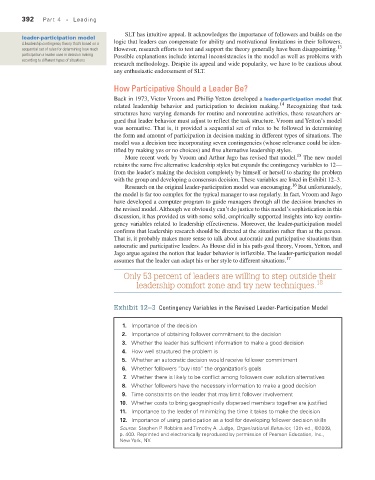Page 393 - Fundamentals of Management Myths Debunked (2017)_Flat
P. 393
392 Part 4 • Leading
SLT has intuitive appeal. It acknowledges the importance of followers and builds on the
leader-participation model
A leadership contingency theory that’s based on a logic that leaders can compensate for ability and motivational limitations in their followers.
13
sequential set of rules for determining how much However, research efforts to test and support the theory generally have been disappointing.
participation a leader uses in decision making Possible explanations include internal inconsistencies in the model as well as problems with
according to different types of situations
research methodology. Despite its appeal and wide popularity, we have to be cautious about
any enthusiastic endorsement of SLT.
How Participative Should a Leader Be?
Back in 1973, Victor Vroom and Phillip Yetton developed a leader-participation model that
14
related leadership behavior and participation to decision making. Recognizing that task
structures have varying demands for routine and nonroutine activities, these researchers ar-
gued that leader behavior must adjust to reflect the task structure. Vroom and Yetton’s model
was normative. That is, it provided a sequential set of rules to be followed in determining
the form and amount of participation in decision making in different types of situations. The
model was a decision tree incorporating seven contingencies (whose relevance could be iden-
tified by making yes or no choices) and five alternative leadership styles.
15
More recent work by Vroom and Arthur Jago has revised that model. The new model
retains the same five alternative leadership styles but expands the contingency variables to 12—
from the leader’s making the decision completely by himself or herself to sharing the problem
with the group and developing a consensus decision. These variables are listed in Exhibit 12–3.
16
Research on the original leader-participation model was encouraging. But unfortunately,
the model is far too complex for the typical manager to use regularly. In fact, Vroom and Jago
have developed a computer program to guide managers through all the decision branches in
the revised model. Although we obviously can’t do justice to this model’s sophistication in this
discussion, it has provided us with some solid, empirically supported insights into key contin-
gency variables related to leadership effectiveness. Moreover, the leader-participation model
confirms that leadership research should be directed at the situation rather than at the person.
That is, it probably makes more sense to talk about autocratic and participative situations than
autocratic and participative leaders. As House did in his path-goal theory, Vroom, Yetton, and
Jago argue against the notion that leader behavior is inflexible. The leader-participation model
assumes that the leader can adapt his or her style to different situations. 17
Only 53 percent of leaders are willing to step outside their
leadership comfort zone and try new techniques. 18
Exhibit 12–3 Contingency Variables in the Revised Leader-Participation Model
1. Importance of the decision
2. Importance of obtaining follower commitment to the decision
3. Whether the leader has sufficient information to make a good decision
4. How well structured the problem is
5. Whether an autocratic decision would receive follower commitment
6. Whether followers “buy into” the organization’s goals
7. Whether there is likely to be conflict among followers over solution alternatives
8. Whether followers have the necessary information to make a good decision
9. Time constraints on the leader that may limit follower involvement
10. Whether costs to bring geographically dispersed members together are justified
11. Importance to the leader of minimizing the time it takes to make the decision
12. Importance of using participation as a tool for developing follower decision skills
Source: Stephen P. Robbins and Timothy A. Judge, Organizational Behavior, 13th ed., ©2009,
p. 400. Reprinted and electronically reproduced by permission of Pearson Education, Inc.,
New York, NY.

